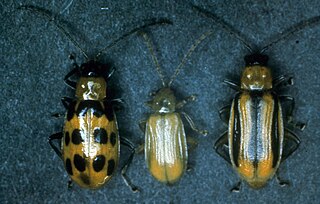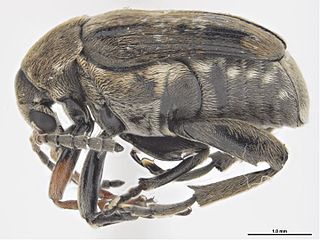
The Japanese beetle is a species of scarab beetle. The adult measures 15 mm (0.6 in) in length and 10 mm (0.4 in) in width, has iridescent copper-colored elytra, and a green thorax and head. It is not very destructive in Japan, but in North America and some regions of Europe, it is a noted pest to roughly 300 species of plants, including rose bushes, grapes, hops, canna, crape myrtles, birch trees, linden trees, and others.

The Asian long-horned beetle, also known as the starry sky, sky beetle, or ALB, is native to the Korean Peninsula, northern and southern China, and disputably in northern Japan. This species has now been accidentally introduced into the eastern United States, where it was first discovered in 1996, as well as Canada, and several countries in Europe, including Austria, France, Germany, Italy and UK.

Pieris rapae is a small- to medium-sized butterfly species of the whites-and-yellows family Pieridae. It is known in Europe as the small white, in North America as the cabbage white or cabbage butterfly, on several continents as the small cabbage white, and in New Zealand as the white butterfly. The butterfly is recognizable by its white color with small black dots on its wings, and it can be distinguished from P. brassicae by its larger size and the black band at the tip of its forewings.

Pieris brassicae, the large white, also called cabbage butterfly, cabbage white, cabbage moth (erroneously), or in India the large cabbage white, is a butterfly in the family Pieridae. It is a close relative of the small white, Pieris rapae.

The Mexican bean beetle is a species of lady beetle that can be an agricultural pest. It is one of the few North American lady beetles that feed on plants rather than other insects. It is found throughout Mexico and the eastern United States, and is abundant in the wetter and more heavily irrigated areas west of the Rocky Mountains. It does not tolerate extremely dry areas.
The American Elm cultivar Ulmus americana 'Exhibition' is a selection made by the Patmore Nurseries from seeds of a tree at Brandon, Manitoba. Released in 1952, 'Exhibition' was propagated by grafting.
The Chinese Elm cultivar Ulmus parvifolia 'Golden Rey' is an American clone patented by B. Rey in 1990.
The Chinese Elm cultivar Ulmus parvifolia 'Pathfinder' is another development by A. M. Townsend of the USDA National Arboretum registered in 1990.
Ulmus davidianavar.japonica 'JFS-Bieberich' is a Japanese Elm cultivar that was raised by the Sunshine Nursery, Oklahoma, from seed collected in China by proprietor Steve Bieberich. Emerald Sunshine proved only moderately successful in the US National Elm Trial, averaging a survival rate of 70% overall.

The American elm cultivar Ulmus americana 'Aurea' was cloned from a tree discovered by F. L. Temple in Vermont at the end of the 19th century.

The American Elm cultivar Ulmus americana 'Columnaris' was propagated by R. E. Horsey of the Rochester N.Y. Parks Department from a tree found by Mr John Dunbar at Conesus Lake, New York, in 1911, and originally described as a forma, Ulmus americana L. f. columnaris, f. nov.Rehder (1922). It was the earliest of a number of compact, columnar American elm cultivars, to be followed by 'Ascendens' and 'Augustine Ascendening'.
The American Elm cultivar Ulmus americana 'Kimley' was cloned c.1957 by the Sheridan Nurseries, Mississauga, Canada, from a large tree found near Oshawa, Ontario, Canada.

Macrodactylus subspinosus is a North American beetle of the family Scarabaeidae. The members of this genus are known as "Rose chafers", not to be confused with the European Rose chafer, Cetonia aurata. M. subspinosus occurs from Eastern Canada to Colorado and is considered a pest of many crops and flowers. It is given its common name of rose chafer because it eats the leaves of roses, although it also feeds on many other plants.
The American Elm cultivar Ulmus americana 'Flick's Spreader' was cloned from a tree discovered by John T. Flick on a farm near Hammon, Oklahoma. Cuttings were given to the Sunshine Nursery, Clinton, Oklahoma, in 1997, which later marketed the tree as 'Flick's Spreader'.

Cucumber beetle is a common name given to members of two genera of beetles, Diabrotica and Acalymma, both in the family Chrysomelidae. The adults can be found on cucurbits such as cucumbers and a variety of other plants. Many are notorious pests of agricultural crops. The larvae of several cucumber beetles are known as corn rootworms.

Bruchus rufimanus, commonly known as the broadbean weevil, broadbean beetle, or broadbean seed beetle is a leaf beetle which inhabits crops and fields, as well as some homes. It is a pest of faba beans. The adult beetles feed on pollen, while their larvae tunnel in seeds destroying crops and moving on to new ones once they dry out. The adult beetle, being one of the biggest of its genus, ranges from 3 to 5 mm in length.

Odontopus calceatus is a species of weevil which occurs in much of the eastern and southeastern United States. Its range is as far north as Massachusetts all the way south to the Gulf of Mexico, and from the Atlantic westward to the Mississippi River. Common names include yellow poplar weevil, sassafras mining weevil, tuliptree leafminer, tulip tree weevil, or the magnolia leaf miner.
Liriomyza trifolii, known generally as the American serpentine leafminer or celery leafminer, is a species of leaf miner fly in the family Agromyzidae.

Odoiporus longicollis, commonly known as banana stem weevil or banana pseudostem borer, is a species of weevil found in South Asia and South East Asia.
Oomyzus gallerucae is a species of chalcid wasp in the family Eulophidae. It is a parasitoid of the elm leaf beetle. The adults and larvae eat the eggs of the beetle.
















